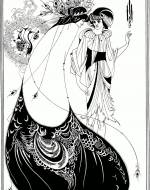Created by Anjali Jaikarran on Wed, 10/28/2020 - 19:49
Description:
First published in 1894, with the English translation of the play, ‘The Peacock Skirt’ is one of sixteen black and white ink framed inset illustrations drawn by Aubrey Beardsley for Oscar Wilde’s play, Salome: A Tragedy in One Act. The illustration depicts the princess Salome, regaled in an elaborate skirt and headdress that are reminiscent of a peacock, conversing with the character known as ‘the young Syrian’. Aubrey Beardsley’s artistic style is a nod to the aesthetic style that emerged in the latter half of the nineteenth century known as art nouveau, as well as the movement of decadence. Art nouveau is characterized by its use of flowing lines and formations that were meant to resemble natural elements such as flowers, vines, and leaves. Decadence valued refinement, artificiality, and established a special interest in the erotic and perverse which challenged the traditional views and values of Victorian society. Beardsley is said to have drawn inspiration from the Pre-Raphaelites. Rossetti’s illustrations from his sister, Christina Rossetti’s work, Goblin Market and Other Poems is said to have influenced his illustrations in Salome, in terms of bringing the fantasy elements of the work to life in an erotic, sensuous, and almost grotesque way. He was also influenced by Japanese art, specifically prints. The use of the black and white colour scheme, as well as the use of sharp, bold lines, allows Beardsley to draw the viewer’s eye to the peacock skirt that Salome is wearing, clearly the main focal point of the image. "In the play, Salome is never mentioned to be wearing such an item. Herod, the king merely mentions gifting luxurious jewels and peacocks to her in exchange for the relinquishment of her request for the head of John the Baptist." (Primorac). Herod says, “Salome, thou knowest my white peacocks, my beautiful white peacocks… there are not in all the world birds so wonderful. I will give thee fifty of my peacocks... I will give them to thee, all." (Wilde 58). Beardsley’s inclusion of this detail may speak to Salome as being seen as ‘the epitome of femininity and elegance’ (Primorac) as she is dressed so lavishly (befitting a princess). Contrastingly, it could also illustrate Salome as the daughter of a sinner, and a sinner herself as John the Baptist brands her (Wilde 21-22), because the lavish dress encapsulates her vanity and lustful behaviour. The skirt further intimates that Salome is an ambitious woman who can achieve whatever she desires (foreshadowing that she achieves her lust for John the Baptist by ascertaining his head in the end), Beardsley furthers this point by constructing her face as conniving and proud through the use of harsh, dark lines. The peacock symbolism furthers the notion of Salome being an object of desirability as peacocks are generally associated with pride, ostentation and beauty, as she is continuously lusted after by male characters in the play such as the young Syrian and Herod. The inclusion of the peacock symbolism could also be Beardsley’s acknowledgement of the roots of his artistic style as peacocks are also associated with luxury and decadence.
Sources:
Aubrey Beardsley, The Pre-Raphaelites, and Victorian Culture
Illustrating Wilde: An examination of Aubrey Beardsley's interpretation of Salome
Copyright:
Associated Place(s)
Part of Group:
Featured in Exhibit:
Artist:
- Aubrey Beardsley


